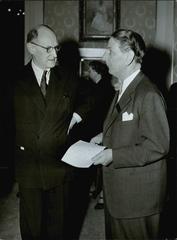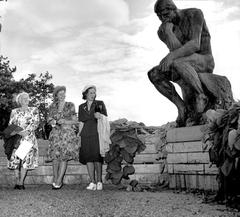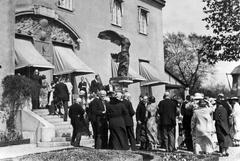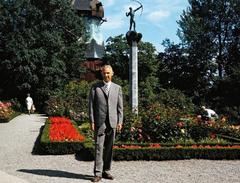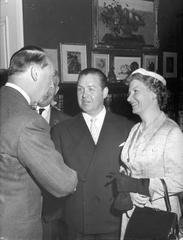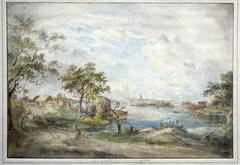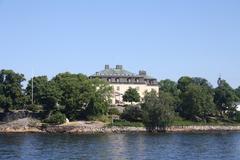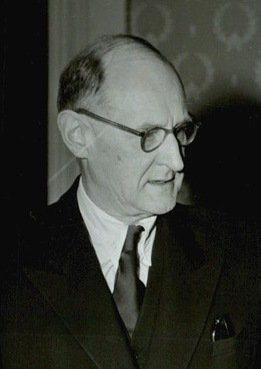
Waldemarsudde Visiting Hours, Tickets, and Guide to Stockholm’s Historical Sites
Date: 14/06/2025
Introduction
Nestled on the verdant island of Djurgården in central Stockholm, Prins Eugens Waldemarsudde is one of Sweden’s most beloved cultural landmarks. Combining history, art, and nature, this former royal residence offers visitors a unique opportunity to explore Swedish cultural heritage in a tranquil setting. Designed in the early 20th century by architect Ferdinand Boberg for Prince Eugen—an influential artist and royal patron—Waldemarsudde boasts panoramic views of Stockholm’s waterways, an extensive art collection, and beautifully landscaped gardens. This guide details everything you need to plan your visit, including up-to-date Waldemarsudde visiting hours, ticket options, travel tips, accessibility information, and highlights of nearby attractions. For the latest details, always consult the official Waldemarsudde website and reputable sources such as Spotting History and Guide to Europe.
Waldemarsudde: History and Cultural Significance
Origins and Early History
Waldemarsudde, meaning “Waldemar’s Point,” traces its history to the 1780s, when the “Old House” and linseed oil mill were built as part of a country retreat for Stockholm’s elite (Spotting History). In 1892, Prince Eugen, a noted landscape painter and youngest son of King Oscar II, first rented a house on the property. Enchanted by the setting, he purchased Waldemarsudde in 1899, reshaping it into an artistic haven.
Prince Eugen: Patron, Artist, and Visionary
Educated in Paris and inspired by European art movements, Prince Eugen (1865–1947) became a key figure in Swedish art, often collaborating with artists like Anders Zorn and Carl Larsson (Swedentips). His vision for Waldemarsudde was to create a residence that was simultaneously a home, studio, and gallery—an environment where art, nature, and architecture converged.
Architectural and Garden Development
Completed between 1903 and 1905, the main mansion—known as “the Castle”—was designed by Ferdinand Boberg, blending Art Nouveau with Gustavian aesthetics. The Gallery Building, added in 1913, introduced modern museum features such as a lantern-lit hall for optimal natural lighting (Artist Studio Museum). Spanning 70,000 square meters, the estate’s park and gardens reflect Prince Eugen’s horticultural interests, featuring ancient oaks, vibrant flowerbeds, and shoreline paths adorned with sculptures by artists like Carl Milles (Svenskt Kulturarv).
Transition to a Museum
Upon his death, Prince Eugen bequeathed Waldemarsudde to the Swedish people. In 1948, it opened as a public museum, preserving the intimate atmosphere of his residence while expanding as a major center for art and culture (Artist Studio Museum).
Waldemarsudde’s Role in Swedish Art and Culture
The Artistic Legacy
Waldemarsudde’s identity is inseparable from Prince Eugen’s dual role as artist and patron. His evocative landscape paintings, marked by masterful use of light and atmosphere, form the core of the museum’s permanent collection (Guide to Europe). Alongside his works, the museum features masterpieces by Swedish and Nordic artists, including Anders Zorn, Carl Larsson, Bruno Liljefors, and Hanna Pauli.
Architectural and Environmental Harmony
Ferdinand Boberg’s mansion design maximizes natural light and frames inspiring views of Djurgården and the Stockholm archipelago (Guide to Europe). The gardens—curated by Prince Eugen—feature a diverse blend of native and exotic flora, outdoor sculptures, and tranquil walking paths, reinforcing the estate’s status as a holistic cultural environment.
The Permanent and Temporary Collections
The museum houses over 7,000 works, including paintings, drawings, sculptures, and decorative arts. The permanent collection is rotated regularly, and temporary exhibitions explore both historical and contemporary themes. Notable recent and upcoming exhibitions include retrospectives of contemporary artists like Gunnel Wåhlstrand and explorations of artist colonies and modernist transitions (Svenskt Kulturarv).
Public Engagement and Accessibility
Waldemarsudde is committed to making art accessible and fostering cultural dialogue. The museum’s programming includes guided tours, educational workshops, lectures, and seasonal events. As a public institution since 1948, Waldemarsudde plays a vital role in Sweden’s museum landscape, championing inclusivity and engagement with diverse audiences (Guide to Europe).
Visitor Information: Hours, Tickets, and Access
Waldemarsudde Visiting Hours
- April – September: Tuesday–Sunday, 10:00–17:00
- October – March: Tuesday–Sunday, 11:00–16:00
- Wednesdays (year-round): Extended hours until 20:00
- Closed: Mondays (except certain public holidays; check website)
Always verify current hours on the official website.
Tickets and Admission
- Adults: 170 SEK
- Students/Seniors: 130 SEK
- Children under 19: Free
- Annual Pass: 350 SEK
Tickets can be purchased online via the museum’s ticket portal or onsite. Guided tour packages and group rates are available.
Accessibility
- Wheelchair Access: Most galleries and public areas are accessible, with ramps and elevators.
- Assistance Dogs: Permitted throughout the museum.
- Hearing Loops: Available in the auditorium.
- Restrooms: Accessible facilities available.
For specific needs, contact the museum before your visit (Waldemarsudde accessibility info).
Guided Tours and Audio Guides
- Public Tours: Offered in Swedish and English, especially on weekends and during exhibitions (museum events calendar).
- Private Tours: Can be arranged for groups; themes include art, history, and gardens.
- Audio Guides: Available in multiple languages via the museum’s app or at the entrance.
Facilities and Amenities
- Cloakroom and Lockers: Free for all visitors; large bags must be checked.
- Restrooms: Including accessible options.
- Café: The Waldemarsudde Café offers Swedish pastries, light lunches, and “fika” on a terrace overlooking the gardens (Waldemarsudde Café). Vegan and gluten-free options available.
- Museum Shop: Features art books, prints, souvenirs, and exclusive planters modeled after Prince Eugen’s designs.
- Wi-Fi: Free throughout the museum.
Outdoor Experience: Gardens and Sculpture Park
The gardens are a highlight, open year-round and free to access. In late spring and summer, floral displays peak, while autumn brings vivid foliage. Notable features include:
- Flower Gardens: Seasonal plantings and perennial beds.
- Sculpture Park: Works by Carl Milles and others.
- Harbor Views: Scenic vantage points over Stockholm’s waterfront.
The gardens are ideal for leisurely walks, photography, and quiet contemplation (Spotted by Locals).
Museum Layout and Navigation
The Waldemarsudde complex includes:
- The Mansion: Main residence and core permanent collection.
- Gallery Building: Hosts temporary exhibitions.
- Old House and Linseed Oil Mill: 18th-century structures reflecting the estate’s early history (Wikipedia).
Wayfinding is clear, and staff are available to assist with directions and information.
Travel Tips and Practical Advice
- Payment: Most transactions are cashless; bring a card (Time Out Stockholm).
- Clothing: Dress for the weather to enjoy the gardens; sturdy footwear is recommended in winter.
- Photography: Allowed in most areas for personal use (no flash or tripods); restrictions may apply during some exhibitions.
- Languages: Swedish and English signage; staff can assist in English. Audio guides available.
- Duration: Allow at least 2–3 hours for a full visit.
Getting There
- Tram: Line 7 (Spårväg City) from T-Centralen or Sergels Torg to Waldemarsudde (terminus).
- Bus: Bus 67 stops at Waldemarsudde.
- Ferry: Djurgården ferries dock at Allmänna Gränd, a 15-minute walk to the museum.
- Car: Limited parking; public transport recommended (Visit Stockholm).
Family and Accessibility Services
- Children: Free admission under 19; activity booklets available at entrance; gardens are child-friendly.
- Wheelchair Loan: Available at the entrance.
- Baby-Changing Facilities: Provided.
Rules and Visitor Conduct
- Bags and Coats: Store in cloakroom.
- Food and Drink: Not allowed in exhibition spaces.
- Phones: Silent mode in galleries.
- Smoking: Prohibited across museum and gardens.
Nearby Attractions
Waldemarsudde is ideally located for a full day on Djurgården:
- Skansen Open-Air Museum (skansen.se)
- Vasa Museum (vasamuseet.se)
- ABBA The Museum (abbathemuseum.com)
- Rosendals Trädgård (rosendalstradgard.se)
A suggested itinerary includes a morning at Waldemarsudde, lunch at Rosendals Trädgård, and afternoon visits to Skansen or the Vasa Museum.
Sustainability and Green Initiatives
Waldemarsudde is committed to sustainable practices, including eco-friendly cleaning, energy-efficient lighting, and seasonal, organic produce in the café. The gardens are maintained using biodynamic principles (waldemarsudde.se).
Frequently Asked Questions (FAQ)
Q: What are Waldemarsudde’s visiting hours?
A: Tuesday–Sunday, typically 11:00–17:00; extended hours on Wednesdays and shorter hours in winter. Closed Mondays. Check the official website for current details.
Q: How much are Waldemarsudde tickets?
A: Adults 170 SEK, students/seniors 130 SEK, children under 19 free.
Q: Can I buy tickets online?
A: Yes, via the museum’s ticket portal.
Q: Is the museum wheelchair accessible?
A: Yes, with ramps, elevators, and accessible restrooms.
Q: Are guided tours available?
A: Yes, in Swedish and English; schedules posted on the events page.
Q: Is photography allowed?
A: Yes, for personal use in most areas; flash and tripods not permitted.
Q: Are the gardens free to enter?
A: Yes, the gardens are open to the public year-round.
Contact Information
- Address: Prins Eugens väg 6, 115 21 Stockholm, Sweden
- Phone: +46 (0)8-545 837 00
- Website: waldemarsudde.se
- Email: [email protected]
Conclusion
Prins Eugens Waldemarsudde epitomizes the harmonious convergence of Swedish art, royal history, and natural beauty. With its richly curated collections, stunning architecture, and serene gardens, the museum offers an immersive cultural experience for all ages and interests. Its accessible facilities, engaging programs, and strategic location among Stockholm’s other top attractions make it a must-visit destination.
Plan your visit by checking Waldemarsudde’s visiting hours and ticketing options online, and consider downloading the Audiala app for guided audio tours and insider tips. For ongoing updates, exhibitions, and special events, follow Waldemarsudde on social media and explore related articles on Stockholm’s historical sites.
Discover where art, history, and nature meet—at Waldemarsudde.

